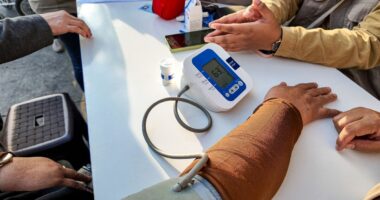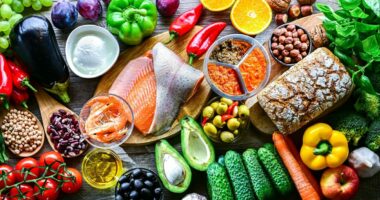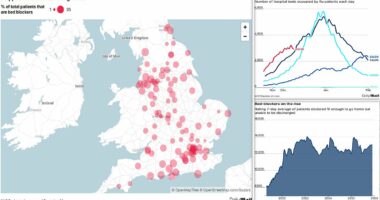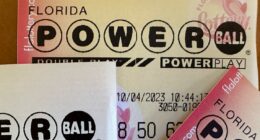Share this @internewscast.com
Gluten-free may not be risk-free.
An investigation has found that dozens of gluten-free products are riddled with toxic heavy metals linked to cancer and autism.
The gluten-free market has boomed in the past decade, amid a wider shift toward ‘clean eating’, endorsements from celebrities like Victoria Beckham, and the perception that the foods under this label are ‘healthier’.
Cassava is a large root vegetable, popular among people on the diet because it doesn’t contain gluten and is versatile; it can be ground into a flour to create gluten-free versions of snacks like cookies.
The watchdog Consumer Reports tested 27 Cassava-based chips, cookies and crackers, among other products — and found some of them contained more lead than they had ever seen in more than a decade of product tests.
Overall, two-thirds of the products contained more lead in a single serving than the organization’s maximum level recommended — up to 2,000 percent above safe levels.
Experts suggest Cassava may absorb lead from the ground, with the toxic metal either naturally occurring or left there by contaminated sewage sludge or fertilizers.
Lead is dangerous because it can damage brain cells, with studies suggesting the toxic metal can leave people with learning difficulties and possibly even autism.
James Rogers, the director of food and safety research at the organization, said: ‘Some of these cassava products had the highest level of lead that we’ve ever tested, and I’ve been with Consumer Reports for eight and a half years.
‘We never want consumers to panic, but we do want them to be aware so they can take proper measures to reduce their lead intake, since long-term lead exposure can lead to adverse health outcomes.’
Eight products — mostly Cassava flour — contained such high levels of the toxic metal that the organization said people should avoid them entirely.
Lead is a toxic heavy metal that is absorbed into the blood from contaminated foods and then travels to the brain, damaging cells.
Studies have already linked lead exposure to a higher risk of learning difficulties and communication problems, with some even suggesting exposure in early life or in the womb may raise the risk of developing autism.
The FDA says there is no safe level of lead exposure, while California says people should not be exposed to more than 0.5 micrograms of lead per day.
Cassava is particularly popular among the more than 3 million gluten-free people in the US because it can be used to replicate much-loved snacks without exposing them to gluten.
Among paleo-diet followers, it is a popular source of carbohydrates when many others — like bread and pasta — are off the menu. Between one and three million people in the US follow this diet, estimates claim.
For the report, Consumer Reports tested one serving of Cassava-based products including chips, flour, crackers, bread, cookies, cereal, pasta, puff snacks, bars, and soda.
Of the eight flours tested, four had lead levels that were so high consumers were told not to eat them. Three others had lead levels per serving between 200 and 600 percent the recommended level.
Of the eight Cassava chips tested, two had levels that were so high that Consumer Reports said they should be avoided. In total, lead levels in the chips ranged from 600 to 1,700 percent.
Overall, Bob’s Red Mill Cassava Flour — sold in Walmart, health foods grocer Sprouts and others — was found to have the highest lead levels, at 2,343 percent higher than the recommended level.
Also in the top ten were Whole Foods-own brand Sea Salt Cassava Tostones Cassava Chips, with lead levels 1,723 percent above the recommended level.
Processing the vegetable into flour concentrates it, which experts say makes lead levels higher.
The report tested the Cassava products for four heavy metals, with the other three being mercury, arsenic and cadmium.

Cassava is a root vegetable that absorbs nutrients from the soil around it while it grows, which experts say may be why it contains higher levels of lead
Mercury was found in none of the products, while there was a measurable amount of arsenic — commonly linked to pesticides, and can cause brain damage and cancer — in half.
Cadmium, a toxic heavy metal that damages organs, was also detected in almost all of the products.
Consumer Reports uses a much lower recommended lead level exposure of 0.5 micrograms per day, which it bases on California’s safe limit.
For comparison, the FDA says that exposure for adults should not exceed 8.8 micrograms per day. For children, it said this shouldn’t exceed 2.2 micrograms.
The difference is because California’s limit is based on health concerns, while the FDA’s indicates where damage has previously been observed.
Rogers added: ‘The negative effects of lead happen over time when there’s chronic exposure, so you won’t get lead poisoning if you eat one serving of these products.
‘However, I would strongly urge consumers to reconsider using the seven products we listed to avoid.’
Consumer Reports contacted 18 of the companies mentioned before publishing its findings, and also sent them their test results.
Nine of them responded, with many saying that lead was a naturally occuring element that could not be completely avoided.
Some also said that they test their ingredients or finished products for heavy metals.
Several companies said that the products tested for the report have since been discontinued, with some acknowledging that concerns about lead in cassava played a role in the decision.
Eight of the companies products carry warning labels on the back over higher lead levels.
This is in line with California’s Proposition 65, which requires any products with lead levels above 0.5 micrograms per serving to carry the warning.













